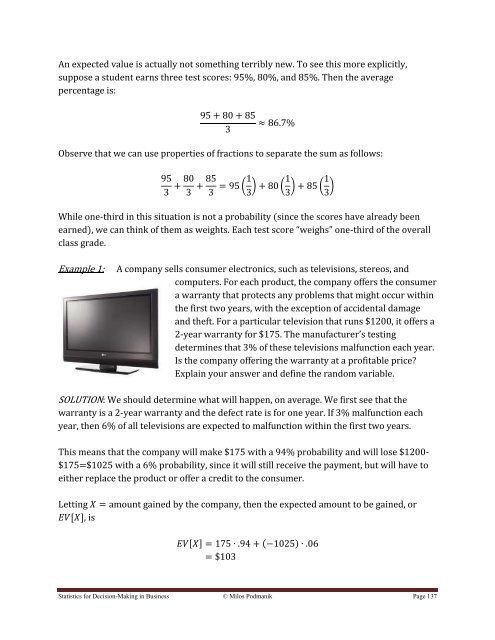Statistics for Decision- Making in Business - Maricopa Community ...
Statistics for Decision- Making in Business - Maricopa Community ...
Statistics for Decision- Making in Business - Maricopa Community ...
You also want an ePaper? Increase the reach of your titles
YUMPU automatically turns print PDFs into web optimized ePapers that Google loves.
An expected value is actually not someth<strong>in</strong>g terribly new. To see this more explicitly,<br />
suppose a student earns three test scores: 95%, 80%, and 85%. Then the average<br />
percentage is:<br />
Observe that we can use properties of fractions to separate the sum as follows:<br />
( ) ( ) ( )<br />
While one-third <strong>in</strong> this situation is not a probability (s<strong>in</strong>ce the scores have already been<br />
) “ ” -third of the overall<br />
class grade.<br />
Example 1:<br />
A company sells consumer electronics, such as televisions, stereos, and<br />
computers. For each product, the company offers the consumer<br />
a warranty that protects any problems that might occur with<strong>in</strong><br />
the first two years, with the exception of accidental damage<br />
and theft. For a particular television that runs $1200, it offers a<br />
2-year warranty <strong>for</strong> $ ’<br />
determ<strong>in</strong>es that 3% of these televisions malfunction each year.<br />
Is the company offer<strong>in</strong>g the warranty at a profitable price<br />
Expla<strong>in</strong> your answer and def<strong>in</strong>e the random variable.<br />
SOLUTION: We should determ<strong>in</strong>e what will happen, on average. We first see that the<br />
warranty is a 2-year warranty and the defect rate is <strong>for</strong> one year. If 3% malfunction each<br />
year, then 6% of all televisions are expected to malfunction with<strong>in</strong> the first two years.<br />
This means that the company will make $175 with a 94% probability and will lose $1200-<br />
$175=$1025 with a 6% probability, s<strong>in</strong>ce it will still receive the payment, but will have to<br />
either replace the product or offer a credit to the consumer.<br />
Lett<strong>in</strong>g<br />
, -, is<br />
, then the expected amount to be ga<strong>in</strong>ed, or<br />
, - ( )<br />
<strong>Statistics</strong> <strong>for</strong> <strong>Decision</strong>-<strong>Mak<strong>in</strong>g</strong> <strong>in</strong> Bus<strong>in</strong>ess © Milos Podmanik Page 137
















